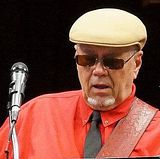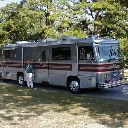Go to...  | Start A New Topic  | Search  | Notify  | Tools  | Reply To This Topic  |  |
Does anyone have a Jake or Pac Brake with a 3208T? I am thinking about putting one on my 40' Regency...but have some concerns about the RPMs going above (3000). Everyone tells me not to get the RPM above 3000. If you are running a Jake/Pac does your RPM accelerate high (above 3K) when engaged? | |||
|
Al, I don't know about in a 3208 application, but I have years of experience with Jake equipped trucks... the jake works to slow you down, reduce RPM, so, it depends on where you allow it to cut on. Your Jake works to add backpressure to the engine assembly and slowing the vehicle down. It's a brake assist device, better used only where needed. Far too often one hears Jakes on constantly... in town... on flat hiways... Some truckers just like the sound. A Macho thing... make them seem "tough" or something. Silly. Like the question about "Jake and Cruise Control", (see other post) it should be, IMHO, used sparingly, and only on long grades when you want to save the brakes. | ||||
|
We have the Pac brake on our 3208T Gillig 38' wide body, and I can say the effect is mild, but helpful. I have not noticed the RPM'S increase to any great degree, but being the engine is so quite back there and when going down a long hill I keep my eyes on the ROAD. Being an old formula Vee driver I have always braked LATE, and this is not what ones should do in an RV for sure, so I have had to work on leaving more space and too allowing the transmission to do its thing by down shifting. The Pac brake does not make the noise I hear truckers making, but I have not been at a high speed and then down a steep and long decline. I have in my records the cost of our unit, and would be glad to look up if you wish. Ours was installed in 1999 if my memory is correct. We do not switch it on unless we are in hilly country. I hope to learn more too from your post Al. Let's hear from others on this please. Dale | ||||
|
"First Year of Inception" Membership Club |
Hey Dale, is a PAC brake an exhaust brake? And, how do you adjust the degree of it's influence on your braking. Do you have a lever, dial or something? | |||
|
Dave, yes it is an exhaust braking system. It has an air compressor, pressure switch, solenoid,air cylinder that mounts direct to exhaust, relay, and either a foot or dash switch. Ours has a lighted on-off dash switch. Turning it on starts the compressor,and then the exhaust brake is actuated. Compressor will remain on momentarily until the pressure in the air cylinder is reached. Compressor will then shut off, but the exhaust brake will remain on. Applying slight pressure to the throttle pedal will cause the air pressure to exhausted through the quick release valve and the exhaust brake returns to OFF position. As I understand the butterfly in the exhaust pipe closes thus putting back pressure on the engine which in turn aids in slowing the RV. As I understand the system the only way one could make it more sever would be to increase the PSI required to reopen the butter fly, but PAC set the PSI limit based on engine type. The 3208 is preset at 25 PSI. I trust I have been helpful. Dale | ||||
|
| "First Year of Inception" Membership Club |
does anyone know if a pac brake is practicle or would work on the 8.2 non turbo engine? 205 hp. mike | |||
|
The booklet I have says "8.2 20 PSI, and limited to engine serial number 8G0150391 and newer" Dale | ||||
|
| "First Year of Inception" Membership Club |
thanks dale for the info, now i'll have to check serial # and see if i qualify.  mike ------------------ mike foster 83-35' regency 8.2 detroit towing 98 cherokee classic 4x4 | |||
|
The shop foreman at Penn Detroit Diesel, Buffalo, a guy who cut his teeth on 8.2's, told me DO NOT put an exhaust brake on one, NO MATTER WHAT the manufacturer said... the serial number your literature mentions most likely reflects the head-bolt change... Detroit put a sightly larger head bolt in the block... took away a lot of the head problems (see other post from Jim and Barb Rustige) but really is a marginal fix. these engines NEVER should get hot, EVER. Creating back-pressure at the exhaust side of the head will heat it up unevenly, even slightly. Even with the new bolt upgrade, it's an iffy proposition... | ||||
|
PS ironsides... are you sure you have a non-turbo 8.2? the HP rating for the early turbo 8.2 is 205... normally aspirated is less than 200. The Turbo is hard to see up front just above the transmission... | ||||
|
I can only say that Pac brake says yes to the serial number stated, and one should note that at 20 PSI that this kit is the least amount of PSI of any kits they offer. Some kits go as high as 65 PSI and one could read between the lines that they may be saying, IT AIN'T GOING TO HELP MUCH., and more PSI will kill the engine life. 20 is less than 1/3rd of their largest kit so it is going to be less effective. Mine at 25 PSI may explain why I say the Pac brake effect I have noticed is MILD. One could assume it is not worth the money in this case, and maybe even mine. Dale | ||||
|
 8/09 8/09 |
Our '95 Regency came with the PAC brake installed, lighted dash switch either on or off. The slowing and braking is noticeable and yes the RPM's do increase as it downshifts to slow the coach. I usually turn it off on the Interstates although my wife likes to leave it on when she's driving. One of the biggest effects is decreasing wear on brakes, as well as the safety factor of slowing to exit a ramp or in traffic. We agree that looking ahead and slowing earlier rather than later has many positive benefits, one minor one being fuel consumption! Cheers..... | |||
|
I spoke with representitives from both DDC and Pac Brake. They both told me that the 8.2 was not designed to use an exhaust brake. | ||||
|
| Powered by Social Strata |
| Please Wait. Your request is being processed... |
|
This website is dedicated to the Barth Custom Coach, their owners and those who admire this American made, quality crafted, motor coach.
We are committed to the history, preservation and restoration of the Barth Custom Coach.
We are committed to the history, preservation and restoration of the Barth Custom Coach.

